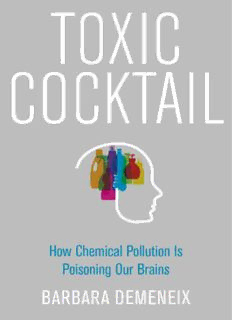
Toxic cocktail: how chemical pollution is poisoning our brains PDF
Preview Toxic cocktail: how chemical pollution is poisoning our brains
i Toxic Cocktail ii iii Toxic Cocktail How Chemical Pollution Is Poisoning Our Brains Barbara Demeneix 1 iv 1 Oxford University Press is a department of the University of Oxford. It furthers the University’s objective of excellence in research, scholarship, and education by publishing worldwide. Oxford is a registered trade mark of Oxford University Press in the UK and certain other countries. Published in the United States of America by Oxford University Press 198 Madison Avenue, New York, NY 10016, United States of America. © Oxford University Press 2017 All rights reserved. No part of this publication may be reproduced, stored in a retrieval system, or transmitted, in any form or by any means, without the prior permission in writing of Oxford University Press, or as expressly permitted by law, by license, or under terms agreed with the appropriate reproduction rights organization. Inquiries concerning reproduction outside the scope of the above should be sent to the Rights Department, Oxford University Press, at the address above. You must not circulate this work in any other form and you must impose this same condition on any acquirer. Library of Congress Cataloging- in- Publication Data Names: Demeneix, Barbara. Title: Toxic cocktail : how chemical pollution is poisoning our brains / Barbara Demeneix. Description: Oxford : Oxford University Press, [2017] | Includes index. Identifiers: LCCN 2016011950| ISBN 9780190260934 (hardcover : alk. paper) | ISBN 9780190260958 (epub) Subjects: LCSH: Thyroid gland— Effect of chemicals on. | Brain— Effect of chemicals on. | Brain— Growth. | Pollution— Physiological effect. | Autism. | Mental illness. Classification: LCC QP188.T54 D46 2017 | DDC 612.4/ 4— dc23 LC record available at http:// lccn.loc.gov/ 2016011950 9 8 7 6 5 4 3 2 1 Printed by Sheridan Books, Inc., United States of America v All scientific work is incomplete. … That does not confer upon us a freedom to ignore the knowledge we already have, or to postpone the action that it appears to demand at a given time. Sir Austin Bradford Hill, “The Environment and Disease: Association or Causation?” Proceedings of the Royal Society of Medicine, 1965 vi vii Contents Acknowledgments ix Abbreviations xi Note to the Reader xv Introduction 1 1. Violet Vapors 11 2. A Molecule of Mystery 29 3. Thyroids in a Chemical Soup 49 4. Losing It: Undoing Brain Evolution 75 5. The Alarming Increase in Autism 93 6. From DNA to Epigenetics 113 7. Counting the Costs 137 8. Who Really Picks Up the Bill? 159 9. Time to Act and How to Act 179 Glossary 207 Notes 211 References 223 Index 245 vii viii ix Acknowledgments This book owes a great deal to many colleagues and friends. I benefited from the expertise of four readers and critics: Dr. Tim Koreevar (Erasmus University, Rotterdam); Dr. Pete Taylor (Cardiff University, Cardiff, Wales); Professor Ana Soto (Tufts University, Boston); and Michael Westlake. The first three, all medically qualified research scientists, took time from their demand- ing schedules to read the first draft with an eye to scientific accuracy and logic. Any remaining errors are my responsibility. Prior to sending them the text, my friend and most critical reader, Michael Westlake, had done a detailed read- through, sug- gesting improvements in expression and pushing me to rewrite where needed. My editor at OUP, Joan Bossert, provided excellent editorial guidance. Both Joan and Lynn Luecken gave me valuable input on structure and organization. Earlier drafts were also read and corrected by family and friends with no scientific back- ground to ensure the level was appropriate for other lay readers. So, my daughter, Ariane; my sister, Louise Keeling; and my long- standing friend, Brenda Swift, read through most chapters, pointing out complex ideas that required better explana- tion and providing insight through their queries. Another friend, Joanne Burden, and my son, Laurent, participated in the brainstorming on titles, as did Aimée Middlemiss and Matt Frost. Thanks to you all. My team in Paris had, yet again, to put up with my preoccupation with the writing and my lesser availability in the lab. I really appreciated your steadfastness. Special mention to doctoral students past and present James Bowers, Jean David Gothié, ix
Description: